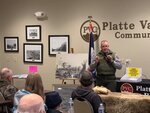TORRINGTON – Let’s face it, Goshen County is full of cattle, good people, and well, history. Nestled beside the great North Platte River, along the Oregon, Mormon, and California trails, …
This item is available in full to subscribers.
To continue reading, you will need to either log in to your subscriber account, below, or purchase a new subscription.
Please log in to continue |




TORRINGTON – Let’s face it, Goshen County is full of cattle, good people, and well, history. Nestled beside the great North Platte River, along the Oregon, Mormon, and California trails, Goshen County has seen the Pony Express and the Texas Cattle Drive.
There is no doubt about it, Goshen County is also packed full of history. From our grand architectural structures seen on Main Street in Torrington to our Homesteaders Museum, Goshen County is quite rich in history.
This week the Goshen County Historical Society shared pieces of the history of our community during their monthly meeting held at 7 p.m. at the Platte Valley Bank Community Room in Torrington on Tuesday.
President Mary Houser called the meeting to order and after a short prayer, the Pledge of Allegiance was recited. Two special guests, Casey Osbeck, and Carter Unverzagt, were introduced and the meeting began.
Houser made a few brief announcements, noting Geri and George Zeimens were finally able to install historical signs along the route to Lingle. There will be a celebration held commencing the signages on May 2. Houser was also pleased to announce the historical society meeting would be aired on Facebook Live.
“Time is precious and again thanks for joining us tonight. There’s a lot of familiar faces and it’s always good to see a lot of my former teachers,” Casey Osbeck, chief of interpretation and visitor services at Fort Laramie National Historic Site said. “So tonight, with the topic at hand, the mystery of Fort William, a very simple title but very complex story and it’s every bit of a mystery. We absolutely do not know where the first fur trade fort is at. Fort William is every bit the mystery it’s always been.”
Osbeck continued by stating the site of Fort John, which was built in 1841 by the American Fur Company, is easily recognizable however, Fort William is a captivating mystery.
Before turning the microphone over to Carter Unverzagt, fort volunteer, Osbeck explained the first archaeological investigations that the National Park Service initiated was in the 1940s.
“I am going to briefly talk about the fur trade and talk a little bit about why that area was chosen for a trading post such as Fort William,” Unverzagt said. “Hopefully you can see the beginnings of why we became a cultural crossroad and a significant part of frontier history.”
Unverzagt explained the area near Fort William was known to Canadian fur trappers and it was on their map as early as the 1790s, but it wasn’t until the Louisiana Purchase in 1803 when American trappers moved west and frequented the area which brought mountain men like Jim Bridger, Thomas Fitzpatrick, Jedediah Smith, and William and Milton Sublette to the area. The mountain men primarily focused on beaver pelts, according to Unverzagt. Since the hides were small, easy to work, and easy to transport, there was no need for fur trading posts in the area. Unverzagt explained summer rendezvous served to buy and sell goods.
“Traders from St. Louis would bring goods and supplies up from St. Louis and then they would meet at a pre-arranged area with the white trappers and the Native Americans where they traded the beaver pelts for the goods and supply and then the traders would take them and transport the pelts back to St. Louis,” Unverzagt said.
Summer rendezvous were utilized from 1825 to 1940, according to Unverzagt, but they began to decline due to the beaver population decreasing and the beaver-pelt hats produced from the hides went out of style. The traders began to then focus on buffalo hides. Unverzagt stated buffalo hides took up more space, they were harder to transport and work so winter storage facilities. Fur trading posts began to pop up all over the Rocky Mountains, according to Unverzagt.
Unverzagt explained Fort William had been constructed of logs, which more than likely contributed to the rapid deterioration. Fort John, an adobe fort was then constructed and according to Unverzagt, Fort William was then abandoned.
Osbeck took the microphone and recalled presenting a similar story to the Rotary Club during a noon meeting.
“I should have started that presentation with ladies and gentlemen what was the business in what would become the state of Wyoming? Right here in Goshen County at Fort William because of the trade and commerce,” Osbeck explained.
“What do we mean by mystery? Well for many years the site of the first fur trade fort, built in June of 1834 along the base of the Laramie and North Platte rivers has been the subject of controversy,” Osbeck said. “As a mentioned before, we don’t know where it was located. Today there have been no archaeological discoveries. For 55 years there’s been 21 National Park Service sponsored archaeological excavations in Fort Laramie,” Osbeck continued. “We haven’t found anything foundation-wise.”
Osbeck explained the post was about 150 square feet, with 15-foot-tall palisades and a trench about three to four feet deep.
“Over the years you would think that with remote sensing and so we would find some sort of ground disturbance today we have not,” Osbeck said.
Osbeck said locating any form of artifact surrounding Fort William was a process of elimination as much of the information describing its location was from dairies and journal entries he’s read through at Fort Laramie.
The meeting wrapped up shortly before 8 p.m.